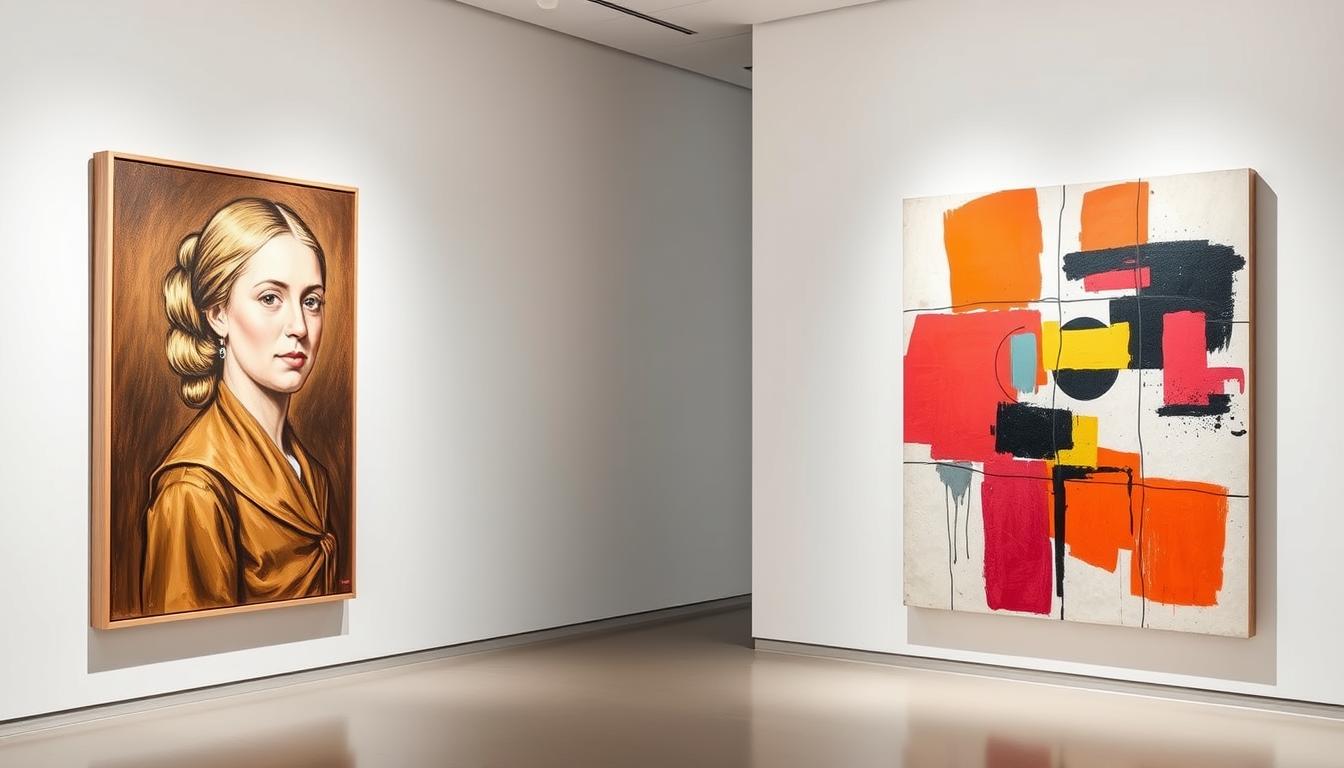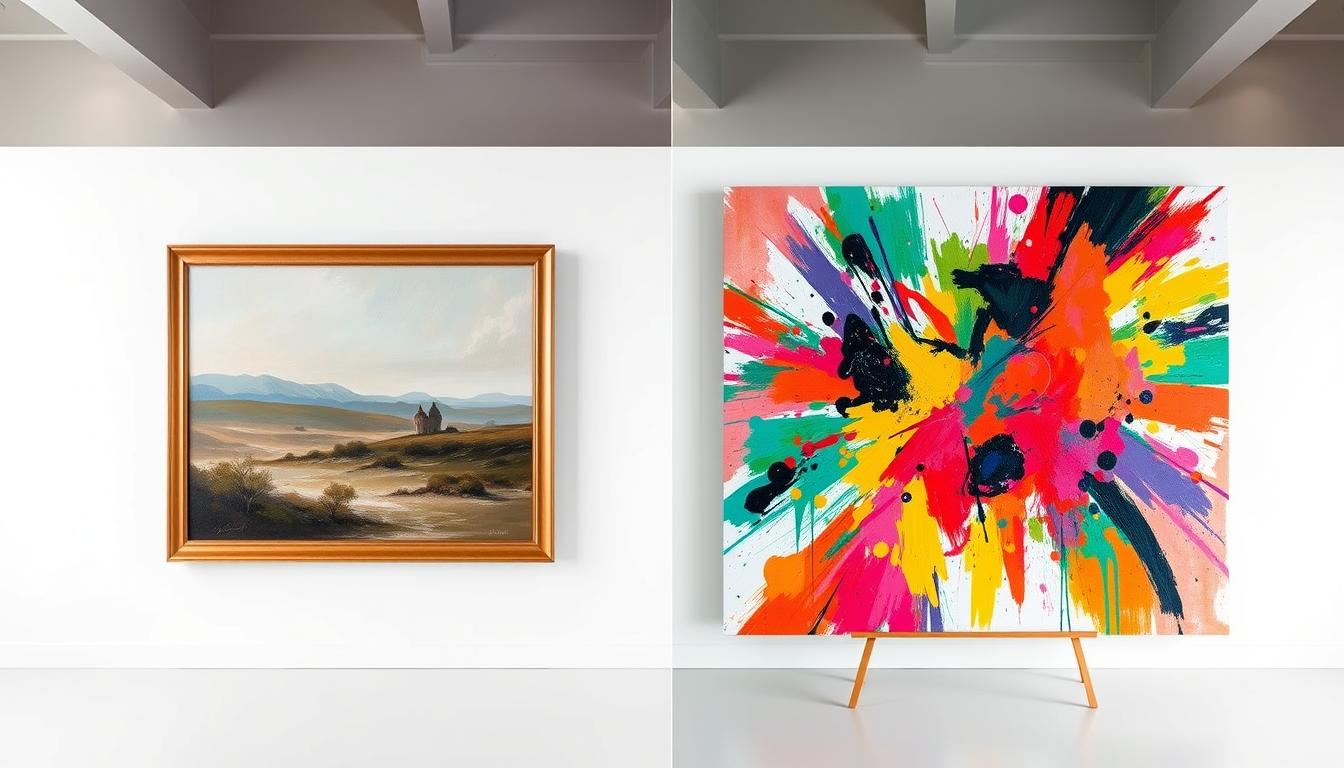That split-second surprise explains why visitors pause in museums and galleries. At stake is a simple question: how do traditional galleries and experimental studios differ in purpose, look, and context?
Broadly, one tradition prizes skill, composition, and beauty learned across centuries, while another celebrates formal risk, color, and process. Both live under the wider umbrella of visual art, and both shape how we read a work, from painting to sculpture.

Labels, dates, materials, and movement names help you tell stories on the wall. Expect representational, abstract, and non-objective pieces to appear in either camp. Artists often blur lines today, so this primer aims to make museum visits clearer and more fun.
For a deeper look at historical examples and clear comparisons, see this short guide on related categories: difference between illustration, fine, modern, and.
Key Takeaways
- Traditional practice highlights technique, balance, and trained composition.
- Modern work emphasizes invention, process, and formal play.
- Contemporary pieces often foreground concept and social context.
- Visual art includes representational, abstract, and non-objective forms.
- Look at dates, materials, and labels to place a work quickly.
- Many artists mix approaches, so clues, not rules, guide viewing.
Fine art and modern art at a glance: why the distinction matters today
A quick glance at a gallery can tell you whether a work leans toward trained technique, formal play, or idea-led practice.
User intent and quick takeaway for the art world and everyday viewers
Short rules of thumb: works stressing refined technique or representational skill usually align with fine art traditions. Pieces that foreground abstraction, gesture, or formal invention point to modern art tendencies. When labels push concept or social questions, you are likely viewing contemporary art.
If you’re visiting a museum, buying a first piece, or following the art world, this quick sense helps you read materials (oil, marble, assemblage), style (painting, sculpture, photography), and purpose.
Where these categories fit within visual art and the broader arts
Visual art covers painting, sculpture, drawing, printmaking, ceramics, photography, video, and mixed media. These categories run in parallel rather than on a ladder; they offer different lenses for the same creative life.
- Time and lineage: fine art traditions span centuries; modern art centers on late 19th–20th century movements; contemporary art reflects post-1970s concerns.
- Practical tip: look for movement names like Cubism or terms like “installation” on labels for quick context.
For a compact comparison and more examples, try spotting the real difference.
Defining the terms: fine art, modern art, and where contemporary art fits
When you stand before a painting or sculpture, clues in form, material, and intent point to different traditions.
Fine art traditionally covers painting, sculpture, and architecture, with drawing later recognized as a stand‑alone discipline. It values skill, proportion, perspective, and the pursuit of beauty that ties the Old Masters like Leonardo and Michelangelo to artists working today.
Modern art marks a turn toward formal experiment. From late nineteenth‑century shifts through Cubism and Abstract Expressionism, painters and makers explored color, texture, and gesture. Figures such as Picasso and Kandinsky focused on surface and structure as subjects in their own right.
Contemporary art centers the idea. Postmodern approaches allow any medium—installation, text, sound, assemblage—and often foreground sociopolitical questions. Duchamp’s readymades, Ai Weiwei’s installations, Barbara Kruger’s text works, Jeff Koons’s appropriations, and Damien Hirst’s provocations show how concept can lead.
"Categories describe emphasis rather than quality; an artist may move between skill, innovation, and concept."
| Category | Primary focus | Typical media |
|---|---|---|
| Fine art | Aesthetics, craft, tradition | Painting, sculpture, drawing, architecture |
| Modern art | Formal innovation, abstraction | Canvas, collage, gesture, large scale works |
| Contemporary art | Concept, discourse, context | Installation, text, sound, mixed media |
What is fine art vs modern art?
A quick timeline helps separate long traditions of representational skill from later experiments in form and process.
Timeline and styles: Traditions that span many centuries emphasize representational painting and sculpted likeness. These works aim to show people, places, and narratives with refined technique.
Modern movements consolidate from the late 1800s through the 1970s. They favor abstraction, and at times non-objective work where color, line, and rhythm replace a visible subject.

Purpose and content
One way to read purpose: older practice prizes aesthetics and craft — mastery, balance, glazing, and modeled form. The content often tells a story or captures likeness.
By contrast, later makers put experiment and idea up front. Duchamp’s readymades and Pollock’s action painting show how process or method can become the subject itself.
Art world context
Museums and markets frame these streams differently. Galleries label earlier rooms with older dates and classical media like oil, marble, or bronze.
Modern movements appear in later galleries, and auction houses value both Old Masters and twentieth-century icons highly. A quick check of years and movement on the label usually answers the question in a gallery.
- A 1600s oil portrait typically falls fine art.
- A color-field canvas or Cubist still life signals modern concerns with structure and perception.
- Materials broaden: from oil and marble to found objects and mixed media.
Materials, media, and methods: from marble and oil to mixed media
Materials shape meaning: a marble column or a ripped newspaper can steer how a viewer reads a piece.
Fine art media: painting, sculpture, drawing, and architecture
Traditional practice favors oil painting, carved marble, bronze casting, and built architecture. Drawing stands as its own discipline, often an artist’s study for larger work.

Experimentation in materials and process
Modern art pushed collage, found objects, and large-scale gestures into the foreground. Visible drips, scrapes, and layered surfaces make process part of the message.
Digital and new media in today’s landscape
Photography, video, and screen-based pieces sit alongside painting and sculpture in galleries. Digital art thrives creatively, though market norms around editioning can affect gallery adoption.
- How to read materials: bronze often feels monumental; paper collage can read as immediate or critical.
- Check edges and joins: chisel marks suggest craft; industrial seams hint at experimentation.
- Labels that list oil, bronze, collage, photography, or video offer fast context.
| Media | Typical materials | What it signals |
|---|---|---|
| Painting / Drawing | Oil, charcoal, paper, canvas | Technique, craft, tradition |
| Sculpture | Marble, bronze, found metal | Monumental, tactile, crafted |
| Mixed & New Media | Collage, objects, photography, video, projection | Process, concept, hybrid practice |
Subjects, styles, and examples that signal each category
Look for subject, surface, and method to quickly place a work in a historical lane or a newer conversation.
Fine art subjects
Portraits show lifelike modeling and careful lighting. Small details in hands, eyes, and costume reveal trained technique.
Religious and mythological narratives use clear iconography to tell a story. These pieces often aim for drama and moral clarity.
Landscapes and seascapes emphasize composition, atmosphere, and layered glazing in many paintings. Grand history paintings stage drama with balanced forms.
Modern movements and signature moves
Cubism fractures space and rethinks perspective so shapes read as constructed planes.
Color-field painting uses broad, luminous zones to set mood rather than depict a scene.
Action painting records gesture; the artist’s movement becomes the visible subject. Minimal and non-objective canvases reduce image to structure and balance.
Representative names and crossovers
Old Masters like Leonardo da Vinci and Michelangelo anchor older practice. Modern innovators such as Pablo Picasso, Wassily Kandinsky, Jackson Pollock, and Marcel Duchamp mark decisive shifts.
Duchamp’s readymade reframes objects as idea; a Rothko-like canvas centers mood through color. Sculpture also signals category: marble saints or bronze equestrians point toward traditional technique, while welded steel and found objects suggest later practices.
Contemporary touchpoints — Andy Warhol, Barbara Kruger, and Ai Weiwei — use photography, video, and industrial objects to foreground concept and social life.
"Scan labels for styles like Renaissance, Cubism, or Abstract Expressionism to place works fast."
| Signal | Typical clue | What it suggests |
|---|---|---|
| Gilded frame & glazing | Layered finish, fine brushwork | Traditional painting practice |
| Raw edges & collage seams | Visible joins, found objects | Modern or contemporary experiment |
| Photography, video, digital prints | Editioned images, screens | Contemporary context, concept-led work |
How to tell them apart in the museum or gallery
Start at the label: the short caption on the wall usually gives you the quickest clues. Look for artist, title, year, medium, and movement to place a work in time and style.
Label clues: dates, movements, and materials
Read the years first. Pre-20th-century paintings often reflect fine art traditions; late 19th to mid-20th-century dates often point to modern art movements.
Scan the medium line. "Oil on canvas" or "carved marble" suggests trained technique. "Collage," "ready-made," "mixed media," or "installation" points toward experimental or contemporary approaches.
Watch for style names on the label: Renaissance, Baroque, Cubism, or Abstract Expressionism give fast context about emphasis and method.
Visual cues: realism vs abstraction, technique vs idea
Compare two nearby works when you can. A realistic portrait will show layered modeling, refined brushwork, and clear draftsmanship. That signals skill-led practice.
An abstract canvas may expose gesture, visible drips, or flat color fields. There, formal choices or process often carry the meaning.
When labels or wall texts frame a concept heavily, the work may prioritize idea over finish. Installation and dispersed objects often rely on context as much as image.
"Let the label guide you, then trust your eyes: note whether surface, method, or concept does the heavy lifting."
| Clue | Typical label or look | What it suggests |
|---|---|---|
| Years | 1600s–1800s | Traditional painting, craft and skill |
| Movement / Style | Cubism, Abstract Expressionism | Formal experiment, modern lineage |
| Medium | Collage, installation, video | Conceptual or contemporary practice |
Conclusion
At their cores, three approaches place different weight on craft, form, and the force of an idea.
, Fine art seeks beauty through mastery, modern art experiments with form and process, and contemporary art centers ideas. Use dates, movements, and medium as a quick checklist, then trust your response to a painting or installation.
Remember that visual art is wide; these labels are tools, not strict rules. Like music, you can enjoy multiple modes at once. Notice materials and objects to read intent, and let that sharpen your sense of what you value in a work by artists today. Revisit galleries with this framework, explore digital art, and pick what moves you.
Enhance Your Space with Unique Modern Masterpieces
Are you inspired by the innovative mediums and conceptual depth highlighted in our exploration of contemporary art? You’re not alone! Today’s art enthusiasts are seeking cultural relevance and emotional connections in their artwork. However, finding pieces that resonate with modern themes and fit your unique style can be a challenge. That’s where we come in!
At Rossetti Art, we specialize in canvas prints, original paintings, and modern sculptures that celebrate the spirit of now. Each piece created by Chiara Rossetti brings a personal touch that connects deeply with current social narratives—just like the modern masterpieces discussed in the article. Don’t miss out on the chance to elevate your home decor with breathtaking artwork that speaks to your values and aesthetic. Explore our collection today and find your perfect piece! Act now, and transform your space into a gallery of inspiration!
FAQ
What separates fine art from modern art in simple terms?
Fine art traditionally emphasizes craftsmanship, beauty, and skill — think oil painting, marble sculpture, careful drawing rooted in training and art academies. Modern art shifts focus toward new ideas, experimentation, and breaking rules. Artists such as Pablo Picasso and Marcel Duchamp prioritized concept, abstraction, and unconventional materials over classical technique.
Why does this distinction matter for museum visitors and collectors?
Knowing the difference helps viewers set expectations when entering a gallery or museum. Labels, dates, and movement names clarify context. Collectors use these categories to assess provenance, market value, and conservation needs: an 18th-century portrait requires different care and expertise than a 1960s mixed-media piece or a contemporary video installation.
How do these categories fit inside the broader world of visual arts?
Both belong to the visual arts umbrella along with photography, architecture, design, and digital media. Fine art often overlaps with classical traditions; modern art marks a historical period (late 19th to mid-20th century) that paved the way for contemporary practices focused on concept and process.
Can you define fine art, modern art, and contemporary art clearly?
Fine art centers on aesthetics, mastery, and enduring techniques. Modern art describes movements like Cubism, Expressionism, and Abstract Expressionism that challenged representation and embraced innovation. Contemporary art refers to work made by living artists, often concept-driven and multimedia, reflecting current social and technological concerns.
How did fine art evolve from the Old Masters to work made today?
Historically, artists such as Leonardo da Vinci and Michelangelo mastered realism, anatomy, and composition for religious, historical, or portrait commissions. Over centuries, training, materials, and patronage shaped technique. Today, many artists blend traditional skills with new ideas, keeping craft alive while exploring fresh themes and media.
What characterizes modern art’s approach to making and meaning?
Modern art favors experimentation: abstraction, fragmented forms, bold color fields, and readymades. It often prioritizes the artist’s process or conceptual statement over narrative content. Works by Wassily Kandinsky, Jackson Pollock, and Duchamp exemplify this shift toward expression and idea.
How do materials and media signal whether a piece leans toward one category?
Classical media like oil on canvas and carved marble often indicate traditional practice. Found objects, collage, industrial materials, and gesture-based techniques point toward modernist and postwar movements. Digital art, video, and interactive installations usually fall under contemporary practice, though overlap exists.
Where do photography and digital work belong in this framework?
Photography emerged as an art form in the 19th century and moved into both fine and modern categories depending on intent and style. Digital and new media are primarily linked to contemporary art but can reference modernist ideas or classical composition, making placement flexible.
Which subjects suggest a piece belongs to a classical tradition?
Portraits, religious scenes, historical narratives, and idealized landscapes often signal ties to academic, classical training. These subjects emphasize representation, storytelling, and technical virtuosity common in older workshops and academies.
What visual signs in a gallery help distinguish realism from abstraction?
Realism shows clear representational detail: recognizable figures, perspective, and modeled light. Abstraction reduces or removes recognizable subjects, focusing on shape, color, surface, and gesture. Labels often include movement names like Realism, Impressionism, or Abstract Expressionism to guide viewers.
Can a single artist work across these categories?
Yes. Many artists evolve through styles over a career. Pablo Picasso moved from realism to pioneering Cubism. Contemporary artists often blend technique and concept, combining careful draftsmanship with experimental media, so strict labels sometimes limit understanding.
How do galleries and museums decide where to place a work historically and thematically?
Curators consider date, materials, artist intent, and movement affiliation. Provenance and critical scholarship inform placement. Museums like the Museum of Modern Art or the Metropolitan Museum of Art organize collections to reflect historical development and thematic connections.
Are market value and public taste affected by these categories?
Yes. Market demand, rarity, and historical significance influence prices. Old masters and iconic modernists command high prices due to rarity and influence. Contemporary works vary widely, driven by living-artist popularity, gallery representation, and current discourse.
How should a casual viewer approach modern or contemporary works they don’t immediately like?
Start by reading the label for date, medium, and artist statement. Consider the idea behind the piece rather than likeness or technical display. Attend gallery talks or read museum guides; context often unlocks appreciation for unconventional materials and concepts.






Leave a comment
This site is protected by hCaptcha and the hCaptcha Privacy Policy and Terms of Service apply.